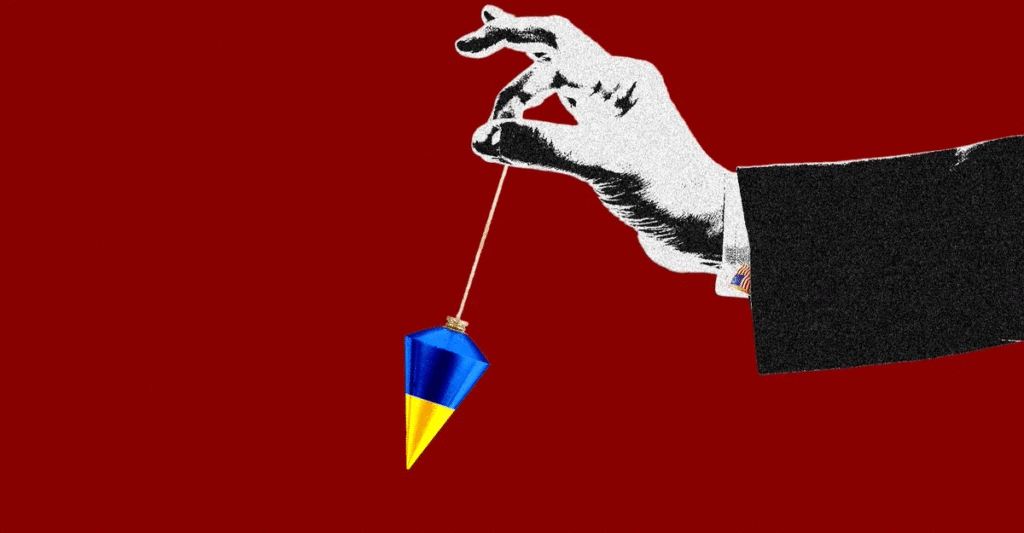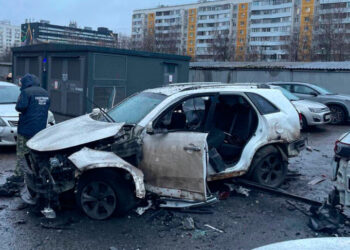In the list of campaign promises from Donald Trump, the one about the war in Ukraine stood out for the number of times he repeated it—“I’ll have that thing ended in 24 hours”—and for the undeniable way he failed to deliver. His self-imposed deadline, of course, passed in January, and the president has since admitted that the belligerents proved much harder to reconcile than he had expected. Still he continues to try. But his efforts have not resembled a peace process so much as a pendulum, swinging between the Russian and Ukrainian positions, with occasional stops in the middle to express frustration over the whole affair.
The latest swing to the Russian side this month has been a doozy. Last week, the White House embraced a 28-point “peace plan” stuffed with the Kremlin’s demands, and Trump gave Ukraine five days to accept it. The task of delivering the ultimatum fell to Dan Driscoll, the U.S. Army secretary, who arrived in Kyiv just as the plan leaked to the media. Its provisions looked to many Ukrainians like a set of demands for their capitulation. But their president, Volodymyr Zelensky, did not turn down the offer from his American guests. “We thought we were going to try to open the door, but the door was open,” a U.S. official said of Driscoll’s visit. “They were ready to talk.”
So were the Americans. As they went over the details, Trump’s Thanksgiving deadline fell away, as did several of the plan’s most onerous provisions. Negotiators whittled the list down to 19 points during a round of talks this weekend in Geneva, and Trump is dispatching another one of his envoys to Moscow to present the amended version to Vladimir Putin. Its fate now depends on the willingness of the Russian president to compromise, and that is where Trump’s peace efforts have so far hit a wall.
The Russians have signaled that they will not budge from their core demands, the same ones Putin spelled out to Trump during the August summit, in Alaska. If they hold firm, then the whole exercise will simply bring the peace process back to its default state of deadlock, leaving Ukrainians to wait once again for some respite from Russian attacks. Even as Driscoll made his pitch in Kyiv on November 19, a Russian strike on an apartment building in the western city of Ternopil killed at least 31 people, including six children, and wounded another 94. The attack brought the total death toll from Russia’s long-range strikes to more than 550 so far this year.
Trump’s latest attempt to end this carnage could be seen as a negotiating tactic, intended to wear away at Moscow’s recalcitrance over time. But most of Trump’s allies in Europe believe this strategy will fail unless the White House accepts two basic things about the war: First, Russia started it. And second, Ukraine and its allies need to force Russia to stop it. That’s what the Europeans have spent the past three and a half years trying to do, and they’re convinced that they can ultimately succeed. “We already had a sustainable plan,” a senior European diplomat involved in implementing it told me. “We don’t understand why the U.S. turned away from it. Clearly, somebody convinced Trump that Ukraine is losing.”
Before the Ukrainians received Trump’s latest ultimatum, they did not appear to be losing the war. On the contrary, fall brought a rare moment of optimism for Zelensky and his aides. Throughout the summer, Russian forces failed to make substantial gains along the front. Ukraine held the line through the mass deployment of combat drones, which forced the Russians to take enormous casualties in exchange for small chunks of territory.
Ukraine’s impressive fleet of long-range drones also pounded Russian oil refineries throughout summer and fall, causing fuel shortages across the country. One of the Ukrainian officials behind this campaign of deep strikes into Russia described it as a key to winning the war. “We cannot defeat them on the front lines. That’s true,” he told me. “But we can defeat them in other ways. They have 40 refineries around the country. We know where they are. One at a time, we can turn out their lights.”
Such theories of victory rely on a simple premise: Ukraine, with help from its allies, can win a war of attrition against its vastly larger and more powerful enemy. This belief requires an underlying faith in the frailty of the Russian economy, the Russian political system, or both. The available facts, however, do not suggest either one will collapse anytime soon.
Under the weight of intense sanctions imposed in 2022, Russia’s economy contracted slightly but soon returned to growth, thanks largely to the dose of steroids administered by military spending, which is estimated to stand at more than $150 billion per year. That is roughly equivalent to the size of Ukraine’s entire GDP before the full-scale invasion began. In Russia, “there are no signs that the worsening economy is capable of stopping the war,” Oleg Itskhoki, a Harvard economics professor who studies Russia, concluded last month. “In principle this could go on for a long time,” he told the New Times, one of Russia’s last remaining independent news outlets.
Even Zelensky does not believe that, over the long term, Ukraine can outlast Russia in a war of attrition. But he sees no clear options other than to surrender or to continue fighting, and his people, exhausted as they are, have consistently made their preference clear. Although polls have shown a growing desire among Ukrainians to negotiate an end to the war, solid majorities continue to reject the idea of ceding large amounts of land to Russia in exchange for peace.
Public opinion has thus pressured Zelensky to find new ways to carry on the fight. In early September, he announced that Ukraine’s expanding military industry now produces more than half of the weapons used at the front. Even if the United States cut off military aid, Ukraine’s armed forces could use these weapons to hold back the enemy. The risk of such a cutoff seemed remote this fall. Support for Ukraine has grown stronger across the U.S. political spectrum; nearly three-quarters of Republicans who participated in a Harvard/Harris poll last month said that they want the U.S. to continue sending weapons to Ukraine; 86 percent said that they want to impose more sanctions on Russia to force an end to the war.
As Russian advances stalled along the front line, morale inside Zelensky’s circle rose to a level his team had not seen in more than a year. “He’s come alive again with the hope that we can really win the war,” one of his closest aides told me in late September. “And yes, he’s infected the team with this idea.”
He also seemed to infect Trump. On the sidelines of the United Nations General Assembly, Zelensky made his case that Trump should unleash a fresh wave of U.S. sanctions that might force the Russians to negotiate. According to one person briefed on the meeting, Zelensky took out a map of the battlefield and pointed to the region of Donetsk. He claimed that Ukrainian forces were on the verge of encircling a large group of Russian soldiers in that region, near the front-line city of Pokrovsk. Such a rout would humiliate the Kremlin, demoralize the Russian military, and, Zelensky argued, deepen the war fatigue among Moscow’s elites.
The presentation struck a chord. In a post on social media, Trump declared that Ukrainians may be able to “take back their Country in its original form and, who knows, maybe even go further than that!” The prediction went well beyond even the rosiest forecasts of military experts, because it would entail Ukraine retaking all of its occupied territory, including Crimea, and then potentially conquering chunks of Russia itself. Such an outcome would be possible, Trump suggested, once the Russian people “find out what is really going on with this War.”
Less than an hour after the post hit Truth Social, Zelensky gathered a group of reporters in a windowless meeting room beneath the UN headquarters in New York City. We all wanted to know how he had changed Trump’s mind, but Zelensky declined to discuss the details. He only expressed relief that his arguments had swayed his most important ally. “This post is a big shift,” he said. “Trump is a game changer.”
The meeting in New York marked a high point in the relationship between Trump and Zelensky. But the good vibes did not last. The White House shifted attention later that week to the war in the Middle East. After months of negotiations, the U.S. persuaded Israel to accept a 20-point plan to end the war in Gaza. Steve Witkoff, the special envoy, led those negotiations alongside Trump’s son-in-law Jared Kushner.
The Gaza deal, which took effect on October 9, did not earn Trump the Nobel Peace Prize that he had coveted; it was awarded the following day to a dissident in Venezuela. But Israelis celebrated Trump as a peacemaker. During a speech at the Knesset on October 13, Trump promised that Witkoff and Kushner would soon turn their attention to ending the war in Ukraine. “I thought it would be easily settled,” Trump said. “But this came first, and we’ll get that one.”
In reality, Witkoff had been trying for months to negotiate with Russia, and he had shown himself to be among Putin’s most eager listeners. When Witkoff first visited the Kremlin, in the spring, Trump expected the talks to be brief. “Steve had no idea about Russia, had no idea about Putin,” Trump recalled in his speech at the Knesset. “Didn’t know too much about politics, wasn’t that interested.” The meeting went on for five hours. “That’s a talent,” Trump said.
From his seat in the audience, Witkoff beamed. The following day, he held a phone call with Putin’s chief adviser on foreign affairs, Yuri Ushakov, and proposed a way for the Russians to change Trump’s mind about Ukraine. “I’m even thinking that maybe we set out like a 20-point peace proposal, just like we did in Gaza,” Witkoff told the Kremlin official, according to the transcript published by Bloomberg.
The two envoys agreed that their presidents should speak on the phone in the next couple of days, before Zelensky’s planned visit to Washington, D.C., at the end of that week. Putin and Trump held a phone call on October 16, and they agreed to organize a summit in Budapest to work toward a deal.
When Zelensky arrived the next day at the Oval Office, he found Trump in no mood for his ideas of victory. The promised encirclement of Russian troops around Pokrovsk had not materialized. Instead, the Russians had continued advancing, sending small groups of soldiers to infiltrate the town and set up firing positions. Zelensky brought along another set of maps to explain the state of the fighting in that area, but Trump showed little interest. “It is time to stop the killing, and make a DEAL!” he wrote on Truth Social after that meeting. “No more shooting, no more Death, no more vast and unsustainable sums of money spent.”
The change in tone upset the Ukrainian delegates but did not surprise them. They had experienced such swings in Trump’s position before. The first Oval Office meeting between Trump and Zelensky, at the end of February, had descended into a shouting match, leading the U.S. to suspend all military aid to Ukraine. About 10 days later, after Zelensky reaffirmed his desire to end the war, the White House resumed the flow of aid, and relations got back on track.
The experience led the Ukrainians to adopt a new rule in their diplomacy: Never allow Trump to see Kyiv as an impediment to peace. “We’ll go anywhere,” the close aide to Zelensky said, affirming the president’s willingness to hold peace talks in whatever format Trump prefers. “Trilateral, bilateral, any proposals for a cease-fire rather than capitulation, we’ll accept it.” They also noticed a pattern in Trump’s attitude on Ukraine: It varied widely depending on which of his advisers were in the room. “Trump is like a weather vane. Whoever blows in his ear today, that’s the direction he turns,” the aide told me. “If he’s with Vance and Witkoff, it’s a different Trump.”
Vice President J. D. Vance was fixated on making a deal to end the war at any cost, and he was especially keen to get it done before the midterm elections. But he was forced to share the Ukraine portfolio with Secretary of State Marco Rubio. Since his days in the Senate, Rubio has taken a hard line on the need to limit the global influence of Russia and China, and he seemed far less trusting of his interlocutors in the Kremlin. For a peace deal to work, he believed that the U.S. needed to test Russia’s willingness to abide by the terms. He was more willing than others in the White House to solicit input from Zelensky’s team and ensure their consent to any agreement with the Russians.
The Ukrainians were relieved to learn that Rubio had been put in charge of arranging Trump’s summit with Putin in Budapest. As part of the preparations, Rubio held a call on October 20 with his Russian counterpart, Sergei Lavrov, who rattled off a list of the Kremlin’s demands. The demands were so extreme that Rubio advised Trump not to move forward with the Budapest summit, and the White House canceled the trip. “I didn’t want to have a wasted meeting,” Trump told reporters in the Oval Office. “I didn’t want to have a waste of time.”
The next day, the U.S. Treasury Department imposed sanctions on Russia’s two largest oil companies, Lukoil and Rosneft. Their main customers in China and India began to curtail their imports of Russian crude, threatening the Kremlin’s ability to finance its war in Ukraine. For Zelensky and his European allies, the decision marked a breakthrough. It gave them hope that, over time, the U.S. would continue pressuring Russia to negotiate in good faith rather than trying to force the Ukrainians to accept a deal on onerous terms.
“We do believe that Russia’s ability to continue the war will slowly erode,” the close aide to Zelensky told me. “Their production, their military budget, their economy as a whole—it’s losing strength,” he continued. “Now we need to find the strength with our allies, for them to hold us up when we falter, with sanctions, with supplies, with everything.”
The pendulum was about to swing again. In response to the U.S. sanctions, the Kremlin dispatched one of its envoys, Kirill Dmitriev, an alumnus of Harvard and Goldman Sachs who had worked hard to build a rapport with Witkoff in particular. When they met for dinner at a hotel in Miami, Witkoff brought along Kushner, and the three of them continued their talks the next day at Witkoff’s home.
A few days later, Dmitriev reported back to his boss in the Kremlin, Yuri Ushakov. The Americans, he said, wanted to see a list of Russian demands for ending the war. According to the transcript published by Bloomberg, Ushakov wanted to send the “maximum” conditions, adding, “Otherwise what’s the point.” Dmitriev agreed, promising that his contacts in the White House would likely accept whatever they received. “Let them make it like their own,” Dmitriev said. “I think they will not take our version entirely, but at least maximally close to it.”
The document they drafted appears to have formed the basis for the 28-point plan, which Axios published on November 20, setting off a furious effort among Ukraine’s allies in Europe to understand its origins.
One of the most odious terms in the plan concerned the eastern region of Donetsk, which Russia has tried and failed to conquer for years. The document states that this region “will be recognized as de facto Russian, including by the United States.” Witkoff has long called for Ukraine to give up its claim to this region and others that Russia occupies. “The Russians are de facto in control of these territories,” Witkoff told Tucker Carlson in March, after his first official visit to the Kremlin. “The question is: Will the world acknowledge that those are Russian territories?”
Witkoff raised the issue again in his talks with Dmitriev last month. “I know what it’s going to take to get a peace deal done,” he said, according to the transcript published by Bloomberg. “Donetsk and maybe a land swap somewhere.”
Trump’s allies on Capitol Hill were outraged to find this suggestion in the 28-point plan. They pointed out that such an outcome would set a dangerous precedent by rewarding the aggressor. “Ukraine should not be forced to give up its lands to one of the world’s most flagrant war criminals in Vladimir Putin,” GOP Senator Roger Wicker of Mississippi, chair of the Armed Services Committee, said in a statement. “Any assurances provided to Putin should not reward his malign behavior or undermine the security of the United States or allies.”
Vance, who played a pivotal role in pushing Zelensky to accept the 28-point plan, lashed out at its critics. “The political class is really angry that the Trump administration may finally bring a four year conflict in Eastern Europe to a close,” Vance said in a social-media post. “It disgusts me.”
Another provision in the plan directly contradicted the efforts of European nations to pressure Russia. They have tried for months to use the $300 billion in frozen Russian assets to help Ukraine sustain the war effort and repair the damage from Russian attacks. Instead, the plan called for $100 billion to be “invested in US-led efforts to rebuild and invest in Ukraine.” Half of the profits from these investments would go to the United States, and Europe would unfreeze some of the other assets to be used for a “separate US-Russian investment vehicle that will implement joint projects in specific areas.”
Such provisions led some of Ukraine’s allies to suspect that the Russians had used the promise of financial gain to win over the Trump administration. The senior European diplomat told us that it looked like a “sausage in front of the American nose.”
But Trump’s willingness to embrace the document had more to do with Ukraine’s weakness at the time. On November 10, investigators in Ukraine announced one of the biggest anti-corruption cases in the country’s history. Although Zelensky was not implicated in the scandal, Vance and other officials in the White House believed that it would leave the Ukrainians in no position to resist a peace deal.
Driscoll’s visit to Kyiv was originally planned for December. But the White House asked him to go earlier, and with a different mission. He needed to gauge the Ukrainian readiness to grant concessions in the peace process. By the time he sat down with Zelensky in the presidential compound, the 28-point plan had been published online, and many Ukrainians were outraged by its terms. A typical headline in the Kyiv Independent described the proposal as pushing Ukraine toward “capitulation” in the war.
After his talks with Zelensky on November 19, Driscoll briefed a group of European diplomats gathered at the U.S. ambassador’s residence. The meeting was tense, if cordial. One of the diplomats demanded to know why the United States had changed course so abruptly, scuttling the effort to pressure Russia through sanctions. The answer, according to a U.S. and a European official, was that other means of ending the war had failed. Any further delays would cost Ukraine more lives and territory, Driscoll said, and Trump wanted to take a new approach.
After a few more days of talks, negotiators from the U.S. and Ukraine came close to giving Trump what he wanted. Their talks in Geneva stripped out several of Russia’s long-standing demands. The next round of talks, in Abu Dhabi, ended with an announcement from Zelensky’s national security adviser, Rustem Umerov: The two sides had reached a “common understanding on the core terms of the agreement.” A U.S. official went further, declaring, “The Ukrainians have agreed to the peace deal. There are some minor details to be sorted out, but they have agreed to a peace deal.”
[Read: Ukraine’s underground generation]
One of these “minor details,” according to one person involved in the negotiations, happens to be the one that Zelensky would find hardest to accept. The provision would require Ukraine to withdraw its forces from the parts of the Donetsk region that it still controls, including Pokrovsk and the other eastern-bastion towns, which serve as a fortified wall against Russian advances. Giving up that territory would be tantamount to political suicide for Zelensky. “If he gives up one square kilometer,” his close aide told us, “that’ll be the main issue in any elections. Every opponent will hammer him for it until he cracks.”
Even Witkoff seemed to recognize this problem all the way back in March, after his first visit to the Kremlin as a peace negotiator. He said in his interview with Carlson at the time that Zelensky would need to acknowledge the loss of territory in eastern and southern Ukraine as part of any deal to end the war. “Can Zelensky survive politically if he acknowledges this?” Witkoff asked. “This is the central issue in the conflict.”
Over the coming days, as Zelensky pushes for another meeting with Trump, he will again need to balance two priorities that look ever harder to reconcile. He will need to respect the wishes of his people not to trade away land they have already made incalculable sacrifices to defend. At the same time, he will need to show Trump that Russia, not Ukraine, remains the obstacle to peace.
The Kremlin’s behavior may help Zelensky. Throughout the latest push to end the war, the Russian armed forces have bombarded Ukrainian cities— the latest barrage killed at least seven people in Kyiv on Tuesday. These attacks could result in yet another swing of the pendulum, bringing Trump back around to the argument that his European allies have been making all along: The Russians are the aggressors in this war, and they must be pressured to end it. As he sends his envoy to Moscow next week, Trump will get another chance to apply that kind of pressure, and Putin will get another chance to talk him out of it.
Missy Ryan and Vivian Salama contributed to this report.
The post Inside Trump’s Latest Push for Peace in Ukraine appeared first on The Atlantic.




